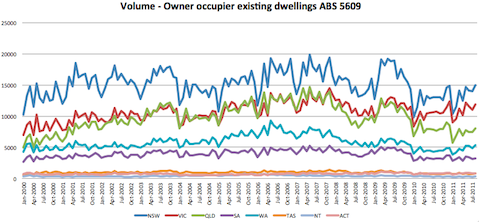As H&H mentioned yesterday, RPData stats are out for September and a glance at the data tells you that the slow melt continues. RPData have taken a bit of a bullish stance on the data, which is in line with their latest newsletter. Here are the numbers:

The big markets of Sydney and Melbourne deteriorated slightly but the big improvements in Brisbane, Perth and Adelaide have lifted the averages.
RPData’s bullishness is premature given this is a single month’s data and we all know it is the trend that matters. But we have seen a little bit of sunshine for housing over the last two months after many months of bad news and the ABS owner occupier data volumes leading into September did show an uptick in volume, so I won’t be too harsh on the report:
There is, however, nothing I can see in either the latest stock on market data from SQM research, or the latest credit aggregates from the RBA to suggest we are seeing a sustained rebound in lending and therefore a market bottom. I have questioned the usefulness of AFG data, but it did forecast this September jump and showed a drop again October (I will revisit that data). RPData disagrees:
In September, capital city home values had their best result in 7 months (down just -0.2 per cent seasonally-adjusted and raw) while regional house values rose +0.1 per cent (s.a.). Including rents, total returns are +0.7 per cent over the first nine months of 2011 and +0.9 per cent over the 12 months to end September.
According to the market-leading RP Data-Rismark Home Value Index, which captured nearly 251,000 sales in the first nine months of 2011 alone, Australia’s soft housing market may be starting to turn the corner. The RBA’s decision tomorrow will determine whether the commencement of any recovery occurs quickly, or is more elongated into 2012. Since 90 per cent of all home loans are variable rate, housing is one of the most interest rate sensitive sectors of the economy.
In the month of September, capital city dwelling values declined by just -0.2 per cent (both seasonally-adjusted and in actual raw terms). This was the smallest decline since February 2011 and was crucial in reversing a trend of accelerating capital losses since end March 2011. Over the first 9 months of 2011, capital city home values have now declined by -3.6 per cent. In the 12 months to 30 September, capital city home values were off by -3.4 per cent.
RP Data-Rismark measures changes in the value of houses across all ‘regional’ markets, which cover the circa 40 per cent of homes not located in the capital cities. Regional house values also recorded a positive result in the month of September, rising by +0.1 per cent (s.a.).
As a number of commenters stated yesterday, we are now seeing a battle of wills between buyers and sellers as to where the market will go next. If there isn’t a need to sell in the short term, because employment holds, then you can expect the market to do what it is now, slowly melt under the influence of low rates of credit growth. Obviously a lowering of rates today will give the market a little more strength, but where the market is right now is a preferable outcome for the RBA and the Australian economy allowing households to deleverage as their asset values hold within a range that doesn’t cause a panic sell. We heard that message from Ric Battelino recently.
I am, however, concerned about how this trend can last with the long term backdrop of Australia’s demographics, but am also aware that recent changes in state government legislation have demonstrated there is still pent up demand for housing and lower values may spur a new round of purchases. Once again it seems to be a balancing act and we need to watch closely which dynamic wins out in the short term. I am obviously of the opinion that the downside risks have more weight than the upside at this point, which is why I agree with H&H’s argument yesterday that a rate cut is needed.
There are big macro issues that could derail everything, specifically in the commodities markets and Europe, if either of these scenarios play out then all bets are off as far as I am concerned.
As an aside, I was talking to a Brisbane real estate agent last night and stated that the market was looking up because there seemed to be far less “for sale” signs than a few months ago. His reply was “Oh yeah that.. No, No the market is still dead but we have stopped putting up signs because there were too many”. That explains that then.
Update: Picking up on a point made by raveswei in the comments I thought I would show the revisions for the August data between the September (indicative) and the October (actual) press releases. You can see from the chart below these revisions are bearish and significant. You can check out the reports yourself if you are interested in the Unit/house break-down.

The full October report is below.
